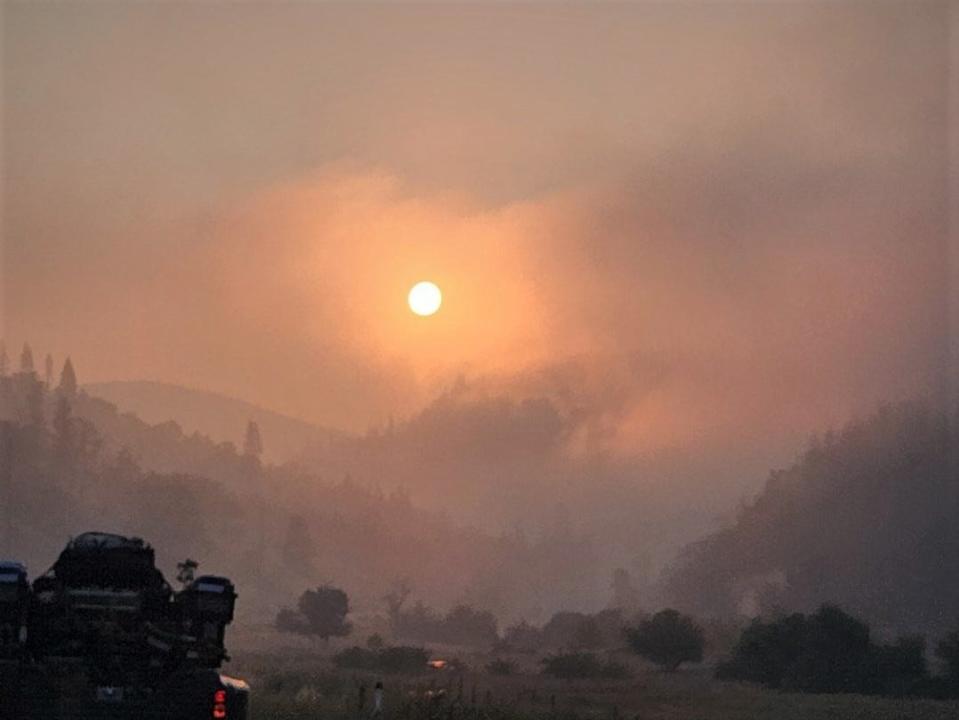Pollution in Stockton is 16 times higher than average as wildfire smoke rolls in
Lightning strikes brought some 50 new wildfires to Western Oregon last week, and now some of those fires have grown into a blazes bringing air quality issues all the way to Stockton and across the Central Valley.
While Valley residents may get a short-lived break from the bad air Wednesday, the thick layer of smoke is expected to roll back into the area Thursday.
The air quality Wednesday morning was 164 - unhealthy for everyone. Earlier Tuesday, the air quality was 140 - unhealthy for most sensitive groups of people.
"The Particulate Matter 2.5 concentration in Stockton is currently 16 times (higher than) the (World Health Organization) annual air quality guideline value," according to an IQAir report Wednesday.
The San Joaquin Valley Air Pollution Control District also had words of warning to residents who've begun to notice the haze rolling in.
"If you can smell smoke and see ash, that is an indication that you are being affected by poor air quality," air district officials warned online."
Weather officials said the wildfire smoke, including soot from Oregon and parts of Canada, continues to impact air quality throughout the U.S., stretching as far east as Chicago.
"The smoke and haze present across much of the Valley this morning will diminish briefly this afternoon," National Weather Service officials said. "However, we're expecting haze and smoke to return overnight and into Thursday morning."
That smoke could continue to pour into the north Sacramento Valley and north Interstate 5 corridor off and on through Friday, according to the NWS.
Winds are blowing smoke south and southeast over Siskiyou and Shasta counties, spreading it from fires now burning in the Klamath National Forest and in northwestern California and Oregon, according to the weather service's Sacramento branch.

Where are the fires?
Firefighters stopped forward progress on the Cottonwood Fire in Oregon Tuesday night. The size of the grass-fueled blaze was estimated at 4,000 acres. It is now in mop-up phase, fire officials said.
Lightning is believed to have caused that fire.
To the south, the Dry Creek Complex fire in Tulare County is nearing a month old and remains a smaller 410 acres. But, the remote fire is being allowed to burn in a controlled manner, sending some smoke into the Valley air.
Cal Fire is investigating the cause of that fire south of Sequoia National Forest.
Klamath National Forest Lightning Complex has slowed its burn, but smoke covering the area has hindered firefighters from getting accurate acreage estimates. That fire has closed portions of the Pacific Coast Trail and major roads in and out of northern California.
It was caused by lightning, firefighters reported Monday.
Other fires include the Lost and Smith River fires in Del Norte, the Deep Fire in Shasta, the August Lightning Fire in Tulare County, the Bedrock Fire in Oregon and the SRF Complex Fire in Humboldt.
Stay safe from smoke:
Particle Matter 2.5, the measurement of pollution, is a concern when levels in the air are unhealthy like this week. Breathing in unhealthy levels of PM 2.5 can increase the risk of health problems such as heart disease, asthma and low birth weights for those who are inundated with smoke.
Check daily air pollution forecasts in your area. The color-coded forecasts can let you know when the air is unhealthy in your community.
Avoid exercising outdoors when pollution levels are high.
Use less energy in your home. Generating electricity and other sources of energy creates air pollution.
Encourage your child's school to reduce exposure to school bus emissions.
Don't burn wood or trash.
Wear a mask.
Protect your indoor air quality with air filters.
Source: American Lung Association
This article originally appeared on Visalia Times-Delta: That haze you see rolling in can have serious health consequences

